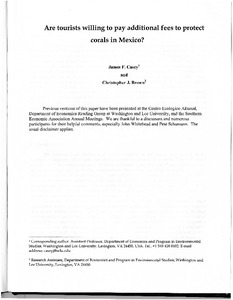| dc.rights.license | In Copyright | en_US |
| dc.creator | Casey, James F. | |
| dc.creator | Brown, Christopher J. | |
| dc.date.accessioned | 2023-10-20T15:49:15Z | |
| dc.date.available | 2023-10-20T15:49:15Z | |
| dc.date.created | 2006 | |
| dc.identifier | WLURG038_Casey_thesis_2006 | |
| dc.identifier.uri | https://dspace.wlu.edu/handle/11021/36241 | |
| dc.description.abstract | Coral reefs have been referred to as the rainforests of the sea, maintaining the most diverse forms of life on earth. The framework built by corals and algae provides the foundation for ecosystems that support an unsurpassed variety of flora and fauna (Moberg & Folke, 1999). Invertebrates, such as hard and soft corals, mollusks, sponges, anemones, sea whips, tube worms, shrimps, crabs, lobsters, clams, starfish, sea urchins and tunicates represent a mere sampling of the diversity of life found in these ecosystems (Cesar & van Beukering, 2004). Unfortunately, fifty-eight percent of the world's reefs are potentially threatened by human activity -- from coastal development and destructive fishing practices to overexploitation of resources, marine pollution, and runoff from inland deforestation and farming (Burke and Maidens, 2004). The primary objective of this paper is to determine if tourists, visiting the Riviera Maya, are willing to pay an entrance fee to enhance coral reef protection. We use a discrete choice contingent valuation (CV) experiment with almost 400 visitors to determine a measure of compensating variation for contributing to a public trust to protect corals. Results suggest there are significant possibilities for implementing a "coral fund" to raise revenues for coral protection programs in the Riviera Maya region of Mexico's Yucatan Peninsula. A secondary objective is to learn more about these tourists: asking the following types of questions -- where are they from, what are they doing, why are they here, how long do they stay, perceptions of environmental
issues. [From Introduction] | en_US |
| dc.format.extent | 20 pages | en_US |
| dc.language.iso | en_US | en_US |
| dc.rights | This material is made available for use in research, teaching, and private study, pursuant to U.S. Copyright law. The user assumes full responsibility for any use of the materials, including but not limited to, infringement of copyright and publication rights of reproduced materials. Any materials used should be fully credited with the source. | en_US |
| dc.rights.uri | http://rightsstatements.org/vocab/InC/1.0/ | en_US |
| dc.subject.other | Washington and Lee University -- Honors in Economics | en_US |
| dc.title | Are Tourists Willing to Pay Additional Fees to Protect Corals in Mexico? | en_US |
| dc.type | Text | en_US |
| dcterms.isPartOf | WLURG038 - Student Papers | en_US |
| dc.rights.holder | Casey, James F. | en_US |
| dc.rights.holder | Brown, Christopher J. | en_US |
| dc.subject.fast | Coral reefs and islands--Economic aspects --Mexico | en_US |
| dc.subject.fast | Coral reefs and islands--Environmental aspects -- Mexico | en_US |
| dc.subject.fast | Tourism--Environmental aspects--Mexico | en_US |
| local.department | Economics | en_US |
